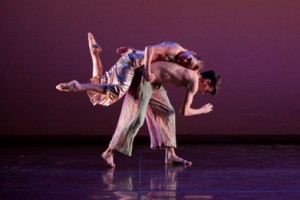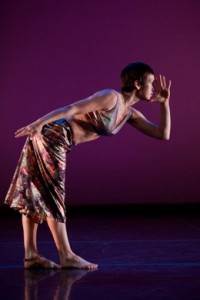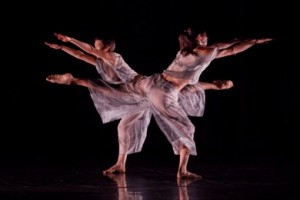JACOB’S PILLOW
Trisha Brown Dance Company
August 10-14, 2011
Review by Anna Rogovoy
(BECKET, Mass., August 11, 2011) – For four decades, Trisha Brown Dance Company has held a place at the forefront of the modern dance world. Before starting her own ensemble, Brown was involved with the Judson Dance Theater, working closely with artists such as Yvonne Rainer and Steve Paxton. The experimental approach she developed to creating dances, including the use of everyday motions and site-specific locations, has influenced scores of choreographers. In her hands, the human body becomes a medium through which currents of energy flow, within and between dancers. The program at Jacob’s Pillow this weekend features four works from the early 70s through this year, each of which illuminates a different facet of this singular artist’s scope.
Les Yeux et L’âme, which premiered earlier this year, is a perfect example of Brown’s flowing tenor. Silky floorwork, lifts in which partners align their centers of gravity allowing for surprising mobility (here we see Paxton’s influence), and canons of leg and arm extensions that flicker through the ensemble are executed with relaxed clarity by all eight members of the company. Ethereal white lighting by Jennifer Tipton and softly draping costumes by Elizabeth Cannon complete an image of otherworldly calm.

Laurel Jenkins Tentindo and Samuel Wentz of Trisha Brown Dance Company in 'Foray Forêt' (photo Karli Cadel)
Less languorous is Foray Forêt. Set to marching band music that rises and falls in volume, as if a parade were growing closer and then further away, the movement has a touch of a regimented quality to match. It’s more intensely physical than Les Yeux in general, with more jumps and sharper swings of the arms and legs. The continuity of energy flow is maintained, but periodic pauses create a wonderful tension which is then broken, as when Tamara Riewe stands still with her back to the audience for a minute before springing into the air. Brown is a little wily here, playing with the boundaries of the stage as disembodied hands emerge from the wings and dancers fall back into unseen arms.
Brown’s quirky sense of humor comes through blazing in Spanish Dance, a concise work for five women (the four females of the company were joined here by rehearsal director Diane Madden). Dressed in white pants and shirts, they stand in a line at the lip of the stage, and pile up like dominos into a many-armed centipede. Swaying their hips as they take tiny step after tiny step, their commitment is integral to the success of this relatively simple piece. Brown seems to be wondering just how long an image can be maintained without losing its engagingness, and she has not overstepped her bounds in the least with this appealingly witty number.
The closing work on the program, Set and Reset is the product of a collaboration between Brown, visual artist Robert Rauschenberg (who also created the costumes and lights for Foray Forêt), and musician Laurie Anderson. Rauschenberg outfits the stage with three video screens and four thin white panels along each wing and the dancers with grey, gauzy, abstractly patterned pants (with matching tops for the women only). Anderson’s score, driven by a thumping bass drum and the repeated words “long time no see”, is at times simple and at times complex, bordering on discordant. The dancers surge from the wings with heightened intensity. Brown’s vocabulary, as established in Les Yeux et L’âme and Foray Forêt, is supplemented with more aggressive kicks, pikes, pendulous lifts, and petits allegros straight out of classical ballet.
For minutes at a time it seems as though a single impulse is being followed and the motion never stops. The stage design and the spatial patterns frame events in unusual ways, with the main action sometimes occurring to an extreme side or towards the back of the stage, behind the trio of screens. The eye flits from one dancer to another, to the video projections, trying to take in the full effect of this multi-layered opus, tantalized by the continuous promise of more detail and nuance. Set and Reset’s lasting power stems not only from the transcendent performances given in it by the accomplished dancers of Trisha Brown Dance Company, but from its confoundingly intelligent complexity, the result of three great artists allowing themselves and each other the time to indulge in creating a viscerally stimulating performance experience.
Anna Rogovoy is chief dance critic for The Rogovoy Report. She studies dance, literature and writing at Bennington College.



1 comment for “(Dance Review) Trisha Brown Dance Company at Jacob’s Pillow”